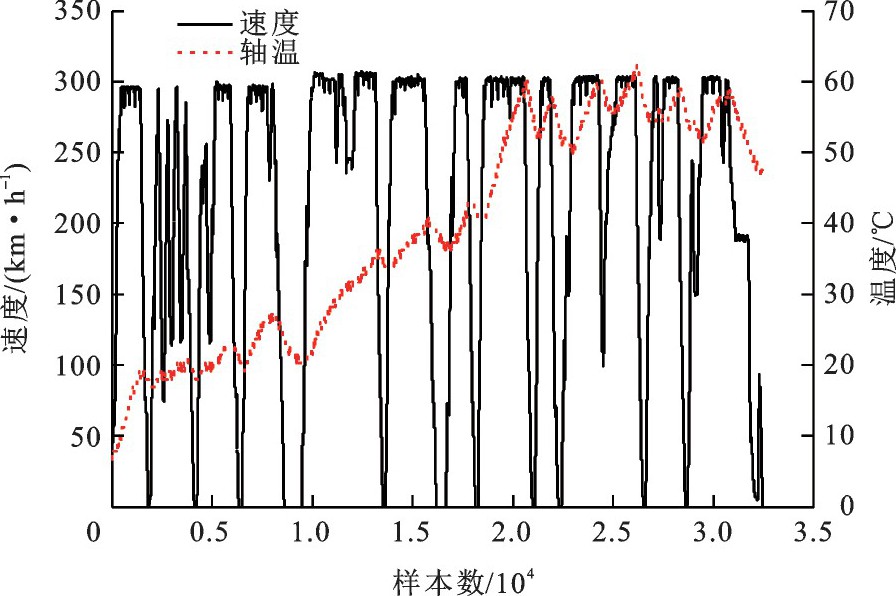Axle temperature threshold prediction model of high-speed train for hot axle fault
-
摘要: 针对现有基于车轴温度固定阈值的故障检测系统适应性差且误报率、漏报率高的问题, 综合考虑列车速度、环境温度与运行工况等因素对轴温的影响以及各因素之间的关系, 建立了高速列车轴温动态阈值预测模型; 考虑高速列车在不同运行工况下轴温变化的差异特征, 将列车运行状态分为加速、匀速和减速3个阶段, 并针对每个阶段运用皮尔逊相关系数法分析列车速度、环境温度、荷载等原始监测数据以及各阶段运行时间、初始轴温等衍生数据与轴温的相关程度; 提取与轴温变化密切相关的因素, 基于多元回归分析方法, 针对列车的3个运行阶段, 分别建立基于原始监测数据的轴温动态阈值预测模型和基于原始监测数据与衍生数据的改进轴温动态阈值预测模型, 并采用F检验方法对模型的有效性进行检验, 基于中国高速列车实测轴温数据对模型的正确性进行了验证。研究结果表明: 列车在加速、匀速与减速3个阶段中, 轴温真实值与改进轴温动态阈值预测模型预测值的平均相对误差分别为2.0%、4.1%和3.3%;相对于基于原始监测数据的轴温动态阈值预测模型, 3个阶段中改进轴温动态阈值预测模型的预测精确度分别提高了79.8%、64.3%和65.6%;改进预测模型的决定系数大于0.99, 显著性概率小于0.05, 表明模型有效。Abstract: Aiming at the problem that the adaptability of existing fault detection system based on the fixed temperature threshold for the axle was poor, and its high false and missing alarm rate, considering the influence of train speed, environment temperature and running conditions on the axle temperature and the relationship among the factors, a dynamic threshold prediction model for the axle temperature of high-speed train was established. Considering the difference in axle temperature variation of high-speed train under different running conditions, the train running state was divided into three stages: acceleration, steady running and deceleration, and aiming at each stage, the Pearson correlation coefficient method was used to analyze the correlation degree between the axle temperature and original monitoring data of train speed, environment temperature and load, as well as that between the axle temperature and derivative data of runningtime and initial axle temperature. The factors closely related to axle temperature variation were extracted, the multiple regression analysis method was used to establish a dynamic threshold prediction model for axle temperature based on the original monitoring data, and a modified dynamic threshold prediction model based on the original monitoring data and derived data for the three running stages of the train. The models were validated using the Ftest method. The model accuracy was verified based on the measured axle temperature data from high-speed trains in China. Research result shows that in the three stages of acceleration, steady running and deceleration, the average relative errors between the true values of axle temperature and the prediction values of the modified dynamic threshold prediction model are 2.0%, 4.1% and 3.3%, respectively. The prediction accuracies of the modified prediction model in the three stage increase by 79.8%, 64.3%, and 65.6%, respectively, compared to the dynamic threshold prediction model for axle temperature based on the original monitoring data. The decision coefficient of the model is larger than 0.99 and the significance probability is less than 0.05, which indicates that the model is effective.
-
表 1 加速阶段原始监测数据的相关性
Table 1. Correlation of original monitoring data in acceleration stage

表 2 加速阶段基于原始监测数据模型的F检验结果
Table 2. F test result of model based on original monitoring data in acceleration stage

表 3 加速阶段基于原始监测数据的模型检验结果
Table 3. Test result of model based on original monitoring data in acceleration stage

表 4 匀速阶段原始监测数据的相关性
Table 4. Correlation of original monitoring data in steady running stage

表 5 减速阶段原始监测数据的相关性
Table 5. Correlation of original monitoring data in deceleration stage

表 6 加速阶段v、C、L、t、T0的相关性
Table 6. Correlation of v, C, L, t, T0 in acceleration stage

表 7 加速阶段改进模型的F检验
Table 7. Ftest of modified model in acceleration stage

表 8 加速阶段改进模型检验
Table 8. Test of modified model in acceleration stage

表 9 匀速阶段v、C、L、t、T0的相关性
Table 9. Correlation of v, C, L, t and T0 at steady running stage

表 10 减速阶段v、C、L、t、T0的相关性
Table 10. Correlation of v, C, L, t, T0 in deceleration stage

表 11 1轴温阈值预测相对误差
Table 11. Relative errors of axle temperature threshold prediction
% 
表 12 2两种模型的轴温预测相对误差对比
Table 12. Comparison of relative errors of two models
% 
-
[1] HE Qing-bo, WANG Jun, HU Fei, et al. Wayside acoustic diagnosis of defective train bearings based on signal resampling and information enhancement[J]. Journal of Sound and Vibration, 2013, 332 (21): 5635-5649. doi: 10.1016/j.jsv.2013.05.026 [2] SNEED W H, SMITH R L. On-board real-time bearing defect detection and monitoring[C]∥IEEE. Proceedings of the 1998 ASME/IEEE Joint Railroad Conference. New York: IEEE, 1998: 149-153. [3] CLINE JE, BILODEAU J R. Acoustic wayside identification of freight car roller bearing detects[C]∥IEEE. Proceedings of the 1998ASME/IEEE Joint Railroad Conference. New York: IEEE, 1998: 79-83. [4] DONELSON J, DICUS R L. Bearing defect detection using on-board accelerometer measurements[C]∥IEEE. Proceedings of the 2002 ASME/IEEE Joint Railroad Conference. New York: IEEE, 2002: 95-102. [5] 易彩. 高速列车轮对轴承状态表征与故障诊断方法研究[D]. 成都: 西南交通大学, 2015.YI Cai. State characterization and fault diagnosis research on wheel bearing of high-speed train[D]. Chengdu: Southwest Jiaotong University, 2015. (in Chinese). [6] 程明. 基于CPCI总线的红外线轴温探测系统的设计和实现[D]. 哈尔滨: 哈尔滨工业大学, 2014.CHENG Ming. Design and implementation of infrared bearing temperature detection system based on CPCI bus[D]. Harbin: Harbin Institute of Technology, 2014. (in Chinese). [7] YUAN Feng-quan, LU Jian-min. Improved condition monitoring system to protect railway axle bearing safety from electric corrosion[C]∥IEEE. Proceedings of the 22nd Industrial Engineering and Engineering Management. New York: IEEE, 2015: 1634-1638. [8] BING Chen-yang, SHEN Hua-bo, CHANG Jie, et al. Design of CRH axle temperature alarm based on digital potentiometer[C]∥IEEE. Proceedings of the 35th Chinese Control Conference. New York: IEEE, 2016: 8842-8845. [9] MILIC S D, SRECKOVIC M Z. A stationary system of noncontact temperature measurement and hotbox detecting[J]. IEEE Transactions on Vehicular Technology, 2008, 57 (5): 2684-2694. doi: 10.1109/TVT.2008.915505 [10] 张运刚, 温晓敏, 姚熊亮. 运行列车轴温规律的模糊分析[J]. 铁道学报, 1996, 18 (3): 20-28. doi: 10.3321/j.issn:1001-8360.1996.03.004ZHANG Yun-gang, WEN Xiao-min, YAO Xiong-liang. Fuzzy and probabilistic regulation of running car box temperature[J]. Journal of the China Railway Society, 1996, 18 (3): 20-28. (in Chinese). doi: 10.3321/j.issn:1001-8360.1996.03.004 [11] ABDUSSLAM S L, RAHARJO P, GU F, et al. Bearing defect detection and diagnosis using a time encoded signal processing and pattern recognition method[J]. Journal of Physics: Conference Series, 2012, 364 (1): 012036-1-13. [12] GLAVATSKIH S B. A method of temperature monitoring in fluid film bearings[J]. Tribology International, 2004, 37 (2): 143-148. doi: 10.1016/S0301-679X(03)00050-1 [13] 汤武初, 王敏杰, 陈光东, 等. 高速列车故障轴承的温度分布研究[J]. 铁道学报, 2016, 38 (7): 50-56. doi: 10.3969/j.issn.1001-8360.2016.07.007TANG Wu-chu, WANG Min-jie, CHEN Guang-dong, et al. Analysis on temperature distribution of failure axle box bearings of high speed train[J]. Journal of the China Railway Society, 2016, 38 (7): 50-56. (in Chinese). doi: 10.3969/j.issn.1001-8360.2016.07.007 [14] 曹源, 王玉珏, 马连川, 等. 基于DTW的车辆轴温监测方法[J]. 交通运输工程学报, 2015, 15 (3): 78-84. doi: 10.3969/j.issn.1671-1637.2015.03.011CAO Yuan, WANG Yu-jue, MA Lian-chuan, et al. Monitoring method of vehicle axle temperature based on dynamic time warping[J]. Journal of Traffic and Transportation Engineering, 2015, 15 (3): 78-84. (in Chinese). doi: 10.3969/j.issn.1671-1637.2015.03.011 [15] CAO Hong-rui, FAN Fei, ZHOU Kai, et al. Wheel-bearing fault diagnosis of trains using empirical wavelet transform[J]. Measurement, 2016, 82: 439-449. doi: 10.1016/j.measurement.2016.01.023 [16] 崔秀国. CRH3型动车组电气系统可靠性研究[D]. 北京: 北京交通大学, 2013.CUI Xiu-guo. Research on the reliability of electrical system for CRH3 electric multiple units[D]. Beijing: Beijing Jiaotong University, 2013. (in Chinese). [17] ZHANG X F, HU N Q, HU L, et al. Enhanced fault detection of rolling element bearing based on cepstrum editing and stochastic resonance[J]. Journal of Physics: Conference Series, 2012, 364 (1): 012029-1-9. [18] SYMONDS N, CORNI I, WOOD R J K, et al. Observing early stage rail axle bearing damage[J]. Engineering Failure Analysis, 2015, 56: 216-232. doi: 10.1016/j.engfailanal.2015.02.008 [19] GERDUN V T, SEDMAK T, ŠINKOVEC V, et al. Failures of bearings and axles in railway freight wagons[J]. Engineering Failure Analysis, 2006, 14 (5): 884-894. [20] 聂晔. 动车组转向架轴承可靠性分析与故障诊断的技术研究[D]. 长沙: 中南大学, 2011.NIE Ye. Research on reliability analysis and fault diagnosis of EMU bogie bearings[D]. Changsha: Central South University, 2011. (in Chinese). [21] 郭伟伟. 红外线轴温探测波形的处理与判别[D]. 哈尔滨: 哈尔滨工程大学, 2006.GUO Wei-wei. Processing and classifying for axle temperature wave of IR detection[D]. Harbin: Harbin Engineering University, 2006. (in Chinese). [22] LIU Q Y. High-speed train axle temperature monitoring system based on switched ethernet[J]. Procedia Computer Science, 2017, 107: 70-74. doi: 10.1016/j.procs.2017.03.058 [23] 刘占功. 提高红外线轴温探测系统热轴兑现率的技术改进方法[J]. 交通运输工程与信息学报, 2004, 2 (4): 105-109. https://www.cnki.com.cn/Article/CJFDTOTAL-JTGC20040400I.htmLIU Zhan-gong. An improvement method of the infrared hotbox detection system[J]. Journal of Transportation Engineering and Information, 2004, 2 (4): 105-109. (in Chinese). https://www.cnki.com.cn/Article/CJFDTOTAL-JTGC20040400I.htm [24] 肖晓娟. 大秦线THDS运用改进及发展研究[D]. 成都: 西南交通大学, 2010.XIAO Xiao-juan. Research on Daqin Line application and improvement of the use of the THDS[D]. Chengdu: Southwest Jiaotong University, 2010. (in Chinese). [25] MOHANTY A R, FATIMA S. Shaft misalignment detection by thermal imaging of support bearings[J]. IFAC-Papers Online, 2015, 48 (21): 554-559. doi: 10.1016/j.ifacol.2015.09.584 [26] 武峥嵘. 基于多点红外探头的铁路轴温热判方法和探测系统研究[D]. 北京: 北京工业大学, 2013.WU Zheng-rong. Research and implementation of hot bearing discrimination technology for train hotbox detection system based on a multi-point infrared detector[D]. Beijing: Beijing University of Technology, 2013. (in Chinese). -





 下载:
下载:














